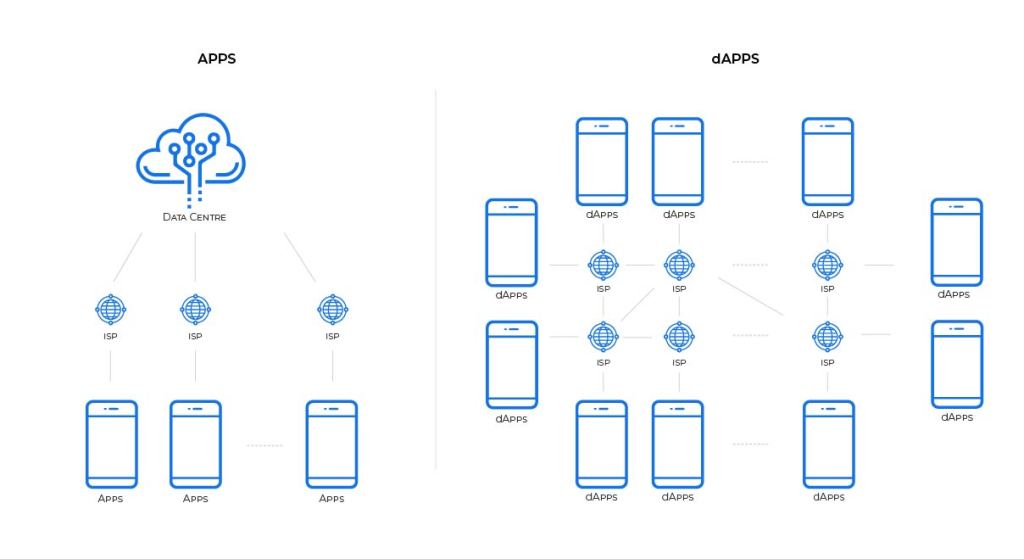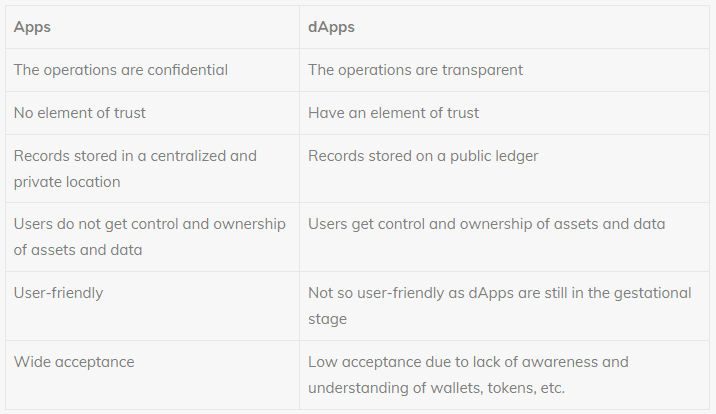Have you ever wondered what is the most pressing problem that internet users face concerning applications? You would agree that it is Data Protection and Privacy.
When you install an app, after installation, the app always asks for a few permissions which include but are not limited to:
Access to your Location and Contacts
Access to hardware features such as Bluetooth, Microphone, Camera
Request to set the app as the default handler of your system
Access to sensitive information like call log and SMS messages
After granting permissions, when you start using the app, your data gets stored at a centralized location. The app is owned by private authorities, who may or may not use your data. Or there could be an attack on the centralized storage network, and your data might get stolen. In any case, you lose ownership of your data.
So, what are dApps, and how do they make a difference?
‘D’ in DApps means decentralized. DApps are Decentralized Applications, which must meet criteria, namely:
Decentralized – It should use cryptographic technology like Blockchain and store all operational records on its public and decentralized ledger.
Incentive – The app should fuel itself with crypto-tokens or other digital assets to reward the validators, who in turn invest their human effort, computing power and electricity to verify transactions and add blocks to the chain.
Protocol – It should have an inbuilt consensus mechanism that agrees on a cryptographic algorithm to show proof of value and generate tokens.
Open Source – The source code of the app must be available to all. It must have an autonomous governing system, where all changes are decided by the consensus of the majority of users.

Difference between apps & dApps

What are the distinct advantages of dApps over traditional apps?
A dApp is an open-source software that leverages on the Blockchain technology. DApps are transparent, distributed, incentivized, and resilient applications. They offer great features, such as proof of ownership, fairness, transparency, etc.
Security
DApps use decentralized networks with Blockchain or other trustless protocols. They keep your data secure as they are tamperproof, keep unalterable records, and are immutable from any sabotage, including hacking.
Immune to a single point of failure
A central authority cannot own or shutdown a dApp as it is decentralized in nature. DApps do not have downtime because they don’t need instructions from a single node. They are not affected by local accidents like fire, earthquake, etc.
Speed
As dApps do not involve intermediate applications like the integrated payment gateways for accepting funds, they enable payment processing faster.
Censorship resistant
Centralized applications like Twitter are subjected to censorship from Twitter itself. Besides, Twitter could decide to shut down anytime. The code that underpins dApps is open source, and no single authority controls them. Hence, dApps facilitate censorship resistance.
DApps have the power to remap the technological landscape. For example, the first dApp, Bitcoin, also known as the internet of money, has successfully decentralized all aspects of transactions and money.
Even though the dApp, Bitcoin, introduced Blockchain technology, it was Ethereum that showed the true potential of Blockchain to the world with a variety of dApps.
Ethereum and dApps
The Ethereum Blockchain, which refers to dApps as Smart Contracts, has popularized dApps. It helped Blockchain evolve from being a purely financial instrument into a platform allowing the distribution of a wide range of dApps.
Before going ahead with the connection of Ethereum and dApps, let’s understand the different types of dApps. The classification of dApps is based on the Blockchain model that they use:
Type 1 - These dApps have their separate Blockchain. Example: Bitcoin
Type 2 - They leverage the Blockchain of type 1 applications, but use their own protocol and tokens for functioning. The Omni Protocol is such an example. The distributed trading platform Omni, is developed on top of the blockchain of Bitcoin.
Type 3 - They use the protocol of type 2 applications. The SAFE Network leverages the Omni Protocol to issue SafeCoins and use them in the functional aspects of its distributed storage.
Ethereum eliminates the need to launch a new Blockchain for every dApp. Instead, it allows developers to run thousands of dApps on top of its platform.
Developers can code smart contracts that serve as the blueprint for the dApp using Ethereum’s language Solidity along with the Turing-complete Ethereum Virtual Machine (EVM). EVMis a quasi-Turing complete machine. Turing completeness is named after Alan Turing, creator of the Turing machine, and refers to a system of data-manipulation rules. EVM uses ‘EVM bytecode’ as its programming language. The code written Solidity can be compiled to the EVM bytecode for the EVM to understand it.
Ethereum helps developers build decentralized applications with emphasis on development time, security, and scaling. Hence, developers have made dApps having real-life use-cases, ranging from logistics & supply chain to education, banking, asset management, and resource planning.
The best examples of dApps on the Ethereum Platform include Golem, Augur, Storj, BAT, etc. Besides Ethereum, other platforms that are competing to create a varied dApp ecosystem include EOS, NEO, VeChain, IOTA, Stellar, and TRON.
The future of dApps
Over the last 2 to 3 years, there has been an explosion of dApps projects in different industries. DApps have reached the stage where the speculative hype to fuel value growth is gone, and there is a focus on their real-world adoption.
We need to consider that dApps also have their share of disadvantages, which include:
Difficulty to scale at a later stage due to the need to implement complex networks and protocols to achieve consensus for data validation.
Problems in updating and bug fixing because it requires each peer on the network to update the copy, which is highly challenging.
Issues in KYC verification as all users have control and verification powers, which delays the task and makes building dApps challenging.
Lack of enough third-party dApps for fetching third-party information for the dApps’ API needs.
Considering how the Blockchain technology has developed our the years, there is no doubt that dApps will find a way to overcome their limitations someday. And with large companies speeding up to grab a place in the Blockchain movement, a world full of self-sustaining, trust-less, and decentralized networks doesn't seem far away.
Share your views on entering the dApps world. And if you wish to build your dApp, put your trust in an experienced company like Promact, which ensures the success of its projects.

We are a family of Promactians
We are an excellence-driven company passionate about technology where people love what they do.
Get opportunities to co-create, connect and celebrate!
Vadodara
Headquarter
B-301, Monalisa Business Center, Manjalpur, Vadodara, Gujarat, India - 390011
Ahmedabad
West Gate, B-1802, Besides YMCA Club Road, SG Highway, Ahmedabad, Gujarat, India - 380015
Pune
46 Downtown, 805+806, Pashan-Sus Link Road, Near Audi Showroom, Baner, Pune, Maharashtra, India - 411045.
USA
4056, 1207 Delaware Ave, Wilmington, DE, United States America, US, 19806

Copyright ⓒ Promact Infotech Pvt. Ltd. All Rights Reserved

We are a family of Promactians
We are an excellence-driven company passionate about technology where people love what they do.
Get opportunities to co-create, connect and celebrate!
Vadodara
Headquarter
B-301, Monalisa Business Center, Manjalpur, Vadodara, Gujarat, India - 390011
Ahmedabad
West Gate, B-1802, Besides YMCA Club Road, SG Highway, Ahmedabad, Gujarat, India - 380015
Pune
46 Downtown, 805+806, Pashan-Sus Link Road, Near Audi Showroom, Baner, Pune, Maharashtra, India - 411045.
USA
4056, 1207 Delaware Ave, Wilmington, DE, United States America, US, 19806

Copyright ⓒ Promact Infotech Pvt. Ltd. All Rights Reserved
